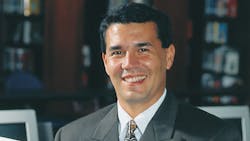Editor's Focus: Transforming Schools
Technology is transforming how teaching and learning is conducted at our nation’s schools and universities. The influx of devices and tools that permeate our lives has provided access to more information at our fingertips than we could ever have imagined—and new technologies are being introduced regularly.
While much attention is focused on the tools students are using that can be incorporated into the learning process (such as laptops, smart phones and tablets) and the resources teachers have at their disposal to bring lesson plans to life (such as high-speed internet access and smartboards), the majority of today’s school and university facilities still resemble the buildings that were planned, designed and built decades ago.
Funding traditionally focuses on areas revolving around technological tools and devices. For example, dozens of education institutions have implemented or are planning to implement programs to provide students with laptops or tablets. Wireless and other advanced networks are being brought into schools to improve internet access. The White House has proposed to increase the education budget by $1.3 billion, including $200 million for teacher technology and database training.
While all of this is welcome and necessary in today’s education landscape, more attention needs to be focused on the spaces where students and teachers congregate during the school day—the building itself.
How many schools still are building computer labs, have a few bulky computers in the corner of a classroom, or have rigid chairs and desks lined in rows facing the teacher’s or professor’s desk at the front of the room? Do you have spaces for students to easily collaborate; charge laptops, tablets and other devices; or make impromptu presentations at any time?
There are many schools and universities, along with their architectural and design teams, that are pushing the envelope when it comes to school planning and design—creating innovative spaces and environments that allow students and teachers to flourish and make the most of the technological tools and devices that are reshaping all aspects of teaching and learning.
It’s time more education institutions embrace how technology is transforming the learning paradigm, and focus on how the built environment can help reinvent, reshape and nurture the educational experience.
SCHOOL SAFETY WEBINAR
Missed this month’s live presentation, “Accelerating School Security”? Now you can view it On-Demand at www.ASUmag.com.
Listen as a dynamic panel of industry professionals discuss such things as how to overcome challenges related to lack of funding, slow procurement process to complete upgrade projects, and more. Speakers include:
- Steve Anderson, Director of Buildings and Grounds, Anoka-Hennepin School District, Minnesota.
- Bill Elvey, APPA Fellow, Associate Vice Chancellor of Facilities Planning & Management, University of Wisconsin-Madison.
- Rhonna Endres, Regional Development Manager, Centennial Contractors.
Sponsored by The Gordian Group, the free informational webinar is a must-listen for anyone tasked with creating safe and secure environments for students, staff and facilities.
About the Author
Joe Agron Blog
Editor-in-Chief and Associate Publisher
Joe Agron is the editor-in-chief/associate publisher of American School & University magazine. Joe has overseen AS&U's editorial direction for more than 30 years, and has helped influence and shape national school infrastructure issues. He has been sought out for comments by publications such as The Wall Street Journal, The New York Times, USA Today, U.S. News & World Report, ABC News and CNN, and assisted with the introduction of the Education Infrastructure Act of 1994.
Joe also authors a number of industry-exclusive reports. His "Facilities Impact on Learning" series of special reports won national acclaim and helped bring the poor condition of the nation's schools to the attention of many in the U.S. Congress, U.S. Department of Education and the White House.
